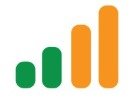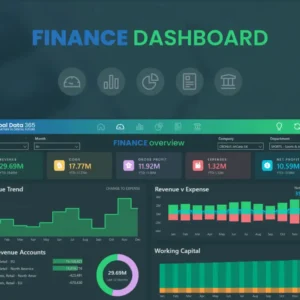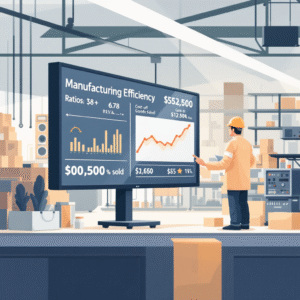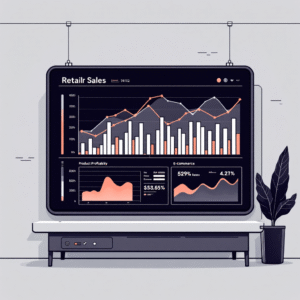In the rapidly evolving field of business intelligence (BI), data visualization tools like Power BI and Tableau are essential for helping organizations unlock insights from their data. Each tool offers a unique suite of features and capabilities, catering to different types of users and organizational needs. For business leaders and data analysts alike, understanding the strengths and limitations of these tools is crucial in selecting the best solution.
Power BI, developed by Microsoft, is widely recognized for its user-friendly interface and affordability, making it accessible for both small and large organizations. It integrates seamlessly with the Microsoft ecosystem, including Excel, Azure, and Office 365, allowing users already familiar with Microsoft products to leverage Power BI with ease. Known for its interactive dashboards, data modeling capabilities, and AI-driven analytics, Power BI is well-suited for organizations looking for a versatile, cost-effective option that supports both self-service and enterprise analytics.
Tableau, now part of Salesforce, has a strong focus on data visualization and exploration, catering to users who need powerful tools for creating visually engaging and detailed dashboards. Tableau’s drag-and-drop interface allows users to explore large datasets intuitively and create a variety of visualizations. While it offers deeper visualization capabilities and more extensive customization options than many of its competitors, Tableau typically comes at a higher cost, which can be a consideration for budget-conscious teams.
When deciding between Power BI and Tableau, consider factors such as cost, ease of use, integration capabilities, and the level of customization required. Power BI may be ideal for those invested in Microsoft products, whereas Tableau excels in visualization and is preferred by teams focused on data exploration and storytelling. Both tools are highly capable, and choosing the right one depends on an organization’s specific goals and technical environment.
The Rise of Data Visualization: Empowering Businesses
Data has become the lifeblood of modern organizations, driving critical decision-making and shaping strategic directions. However, the sheer volume and complexity of data can be overwhelming, making it challenging to extract meaningful insights. This is where data visualization tools like Power BI and Tableau step in, transforming raw data into visually compelling and easily digestible formats.
Power BI: Microsoft’s Powerhouse for Data Visualization
Power BI, Microsoft’s powerful business intelligence platform, has quickly gained traction in the data visualization space due to its seamless integration with the Microsoft ecosystem. With native connections to Excel, Azure, and Office 365, it’s an ideal choice for organizations already invested in Microsoft technologies, providing a smooth transition into robust data analysis and visualization.
One of Power BI’s standout features is its user-friendly interface, which makes creating visualizations and dashboards straightforward, even for non-technical users. Its drag-and-drop functionality enables users to design visually appealing reports quickly, leveraging a variety of pre-built visual elements that can be customized to suit specific data needs. This ease of use helps businesses rapidly generate actionable insights, reducing the time required to make data-driven decisions.
Power BI is also recognized for its powerful data modeling capabilities. It supports complex data structures and relationships, allowing organizations to work with diverse data sources in a unified manner. This flexibility is particularly valuable for companies that handle large datasets or need to combine information from multiple systems. Power BI’s ability to incorporate real-time data also means users can monitor key performance indicators and make adjustments on the fly, which is critical for fast-paced industries.
Furthermore, Power BI offers advanced analytics tools powered by AI, allowing users to conduct predictive analysis and automated insights that drive deeper understanding. Coupled with its scalability—from individual desktops to enterprise-level solutions—Power BI is a versatile tool that supports both self-service analytics and larger-scale BI needs, making it an attractive option for a wide range of organizations.
Tableau: The Data Visualization Powerhouse
Tableau has firmly positioned itself as a leader in data visualization, known for its powerful analytical features and highly customizable visualizations. Unlike Power BI, which is tightly integrated with the Microsoft ecosystem, Tableau is a cross-platform solution, making it ideal for organizations operating within diverse technology environments. This flexibility has contributed to its popularity across industries that rely on data-driven insights from various sources and platforms.
Tableau’s strength lies in its advanced data exploration and visualization capabilities, empowering users to delve deep into their data and uncover hidden trends and patterns. Its intuitive drag-and-drop interface is designed for users of all skill levels, allowing them to create sophisticated, visually engaging dashboards without needing advanced technical skills. Tableau provides a vast range of chart types, visual elements, and customization options, enabling users to tell compelling stories with data and tailor visualizations to meet specific analytical needs.
One of Tableau’s standout features is its robust data connectivity and data blending capabilities. It connects seamlessly to numerous data sources, including cloud platforms, databases, and spreadsheets, allowing organizations to integrate and analyze data from various origins with ease. For companies with complex data landscapes, this functionality enables cohesive and streamlined analysis, reducing data silos and supporting comprehensive, multi-source insights.
Additionally, Tableau’s scalability—from individual users to enterprise deployments—makes it suitable for teams of any size. Its support for real-time data connections also allows users to monitor and update dashboards as new data becomes available, making it a valuable asset for fast-paced decision-making. With these advanced visualization and connectivity options, Tableau is a powerful choice for organizations prioritizing in-depth analytics and dynamic, visually rich data presentation.
Feature Comparison: Power BI vs. Tableau
When comparing Power BI and Tableau, two leaders in data visualization, both offer comprehensive tools and features tailored to meet a wide range of business intelligence needs. Yet, there are key differences in their data connectivity, modeling, visualization customization, collaboration options, and pricing structures, which can make a significant impact on the decision-making process.
- Data Connectivity
Power BI and Tableau both provide extensive connectivity options, enabling users to pull data from various sources. However, Tableau has a slight edge in its capacity to connect to a broader array of sources, including legacy systems and custom data environments. Tableau’s data blending capabilities are particularly robust, allowing users to seamlessly combine data from multiple origins without extensive pre-processing. Power BI, while highly capable, offers deep integration primarily within the Microsoft ecosystem and performs optimally with Microsoft-based databases like Azure and SQL Server. This focus can be advantageous for organizations that primarily rely on Microsoft technologies, but Tableau’s flexibility with diverse data sources may appeal more to organizations with mixed or non-Microsoft data environments.
- Data Modeling
Power BI stands out with its data modeling capabilities, particularly with its DAX (Data Analysis Expressions) language, which allows for sophisticated data transformations and complex calculations. Power BI is designed for organizations that require intricate data modeling to handle complex data structures. DAX functions can enable advanced measures and column creation, making it possible to execute complex analytical tasks within the tool itself. Tableau, in contrast, is generally more focused on data visualization than data modeling. While it offers some modeling capabilities, it lacks the depth that Power BI provides through DAX. This makes Power BI a compelling choice for users who need powerful data transformation and calculation tools as part of their reporting process.
- Visualization Customization
Tableau is renowned for its visualization capabilities, which are highly customizable and allow users to create visually intricate and striking dashboards. The tool provides a vast array of chart types and customization options, which can be fine-tuned to create dynamic, storytelling-focused dashboards. Tableau’s drag-and-drop interface is designed to promote creative data exploration, making it especially popular among users who value design flexibility and aesthetic appeal. Power BI also offers a variety of visualization options, but it’s more structured in comparison. While Power BI supports custom visuals through its marketplace, Tableau’s focus on customization and design is more appealing to those prioritizing sophisticated, presentation-ready visuals.
- Collaboration and Sharing
Power BI’s integration with the Microsoft ecosystem enables seamless sharing and collaboration. With native support for SharePoint, Teams, and Office 365, Power BI makes it easy to embed reports across familiar Microsoft applications, fostering collaboration within organizations heavily invested in Microsoft’s suite of tools. Additionally, Power BI’s cloud service allows users to securely share dashboards and reports within their organization or with external stakeholders. Tableau also provides strong sharing capabilities, though it isn’t as tightly integrated with specific productivity platforms. However, Tableau’s collaboration tools are cross-platform, enabling teams with diverse technology environments to collaborate effectively. Tableau Online and Tableau Server also facilitate sharing and access control, giving organizations flexible options for data sharing.
- Pricing and Licensing
Pricing is another major consideration. Power BI is often viewed as a more cost-effective option, particularly for organizations that already have Microsoft licensing agreements in place. Microsoft’s per-user pricing model for Power BI makes it accessible for both small and large enterprises, with Power BI Desktop being available for free and Power BI Pro offering premium features at a competitive monthly rate. Tableau, while pricier, offers a flexible licensing structure, including per-user, per-server, and cloud options. This adaptability can be valuable for organizations with diverse technology setups or those needing tailored deployment options. For many, the choice between the two may hinge on budget constraints, as Power BI can offer a lower-cost solution for those already within the Microsoft ecosystem.
Choosing the Right Tool: Factors to Consider
When choosing between Power BI and Tableau, it’s essential to evaluate your organization’s unique requirements, data landscape, and technology environment. Each tool offers a comprehensive set of features, but certain factors can help you determine which platform will best support your business intelligence goals.
- Data Complexity and Volume
Start by assessing the complexity and volume of your data. Power BI is known for its strong data modeling capabilities, which include the DAX (Data Analysis Expressions) language, making it suitable for handling complex data structures, relationships, and transformations. This is particularly valuable for organizations dealing with large volumes of data requiring advanced calculations. Tableau, while less focused on data modeling, offers robust data blending and preparation capabilities that enable users to connect and work with multiple data sources seamlessly. If your data requires extensive modeling, Power BI may be the better choice, whereas Tableau is ideal for simpler structures and a more flexible approach to data exploration.
- Visualization Needs
Consider the customization level and visual appeal your organization requires in dashboards and reports. Tableau is renowned for its visually rich and highly customizable dashboards, allowing users to create intricate, engaging visualizations that can uncover patterns and tell a compelling story. Tableau’s drag-and-drop interface and variety of chart types make it a top choice for those prioritizing design and aesthetics in data presentation. Power BI, while also offering a range of visualization options, is more structured and optimized for users within the Microsoft environment. Power BI visuals are customizable to an extent, but Tableau’s flexibility and design emphasis often appeal more to teams with a strong focus on detailed visual representation.
- Collaboration and Sharing
Evaluate how important seamless collaboration and sharing are for your organization. Power BI’s integration with the Microsoft ecosystem, including SharePoint, Teams, and Office 365, facilitates collaboration across departments, particularly for organizations already embedded in Microsoft tools. Power BI also supports secure sharing of dashboards and reports within or outside the organization through its cloud service. Tableau, though not as tightly linked to specific productivity tools, offers cross-platform collaboration options. Tableau Online and Tableau Server allow teams to share data insights across different technology environments, enabling users with diverse systems to collaborate effectively. Choose the tool that aligns best with your organization’s collaboration needs and technology preferences.
- Integration with Existing Systems
Assess each tool’s compatibility with your existing systems and ease of data connectivity. Power BI integrates seamlessly with the Microsoft ecosystem, making it an ideal choice for organizations using other Microsoft services like Azure or SQL Server. Tableau, however, is designed as a cross-platform solution, connecting smoothly with a wider range of data sources, including legacy systems and custom data environments. If your organization has a mixed or non-Microsoft technology stack, Tableau’s flexible integration options might provide a more seamless experience.
- Skill Sets and Training
Consider the technical expertise within your team and the learning curve of each tool. Power BI is generally considered more accessible for beginners, especially for users familiar with Excel, as it shares a similar interface and approach. Power BI also offers robust documentation and training resources, making it easier for non-technical users to get started. Tableau, while intuitive, has a steeper learning curve for those unfamiliar with data visualization principles but provides extensive training options and community support. For teams looking for immediate accessibility, Power BI may have an advantage, but Tableau’s support resources can also be valuable for teams aiming to build advanced visualization skills.
- Budget and Licensing
Finally, evaluate the overall cost of ownership, including subscription fees and any additional expenses for user licenses or custom visualizations. Power BI’s pricing model is often more affordable, especially for organizations with existing Microsoft licensing agreements, which can make it a cost-effective solution for large teams. Tableau, while generally more expensive, provides flexible licensing structures—such as per-user and server-based options—that can cater to organizations with diverse deployment needs. Budget constraints and licensing preferences may heavily influence your choice, with Power BI being more cost-effective for Microsoft-oriented organizations and Tableau offering flexibility for varied environments.
By carefully weighing these factors—data complexity, visualization needs, collaboration requirements, integration compatibility, team expertise, and budget—you can make a well-informed decision aligned with your organization’s specific goals. Taking the time to analyze these considerations will help ensure the successful implementation and adoption of the data visualization tool that best supports your business intelligence objectives.
Conclusion: Unlocking the Power of Data Visualization
In today’s data-driven world, Power BI and Tableau have become leading tools for data visualization, each offering unique strengths suited to different organizational needs. Power BI, developed by Microsoft, is known for its strong integration with the Microsoft ecosystem, making it an ideal choice for organizations already invested in Microsoft technologies. It’s user-friendly and cost-effective, with robust data modeling capabilities that support complex data structures, which is beneficial for businesses requiring extensive data manipulation and transformation.
Tableau, on the other hand, is renowned for its highly customizable and visually appealing dashboards. Designed as a cross-platform solution, Tableau supports a wide range of data sources, making it an excellent choice for organizations with diverse technology environments. Its advanced visualization options enable users to create intricate, engaging dashboards that reveal patterns and insights, making it popular among teams prioritizing data storytelling and aesthetic design.
When choosing between Power BI and Tableau, consider factors like data complexity, visualization needs, collaboration requirements, integration with existing systems, team expertise, and budget. Both tools offer extensive capabilities, but Power BI may appeal more to those needing Microsoft integration and cost-effective pricing, while Tableau may suit organizations focused on flexibility and design.
Ultimately, the right choice empowers your organization to make data-driven decisions effectively. By staying informed on the features, capabilities, and trade-offs of these tools, you can navigate your data visualization journey with confidence. Embrace the adaptability required in this dynamic field, and stay open to exploring new advancements to keep your data insights fresh and relevant.
So, which data visualization tool will you choose to propel your business forward? Share your thoughts and experiences in the comments below.







